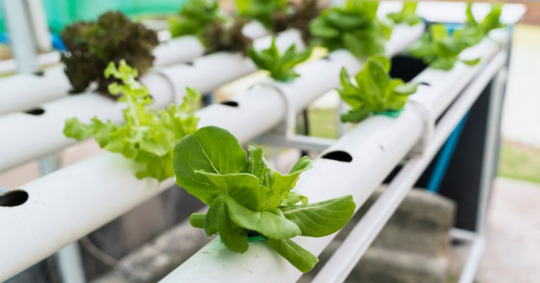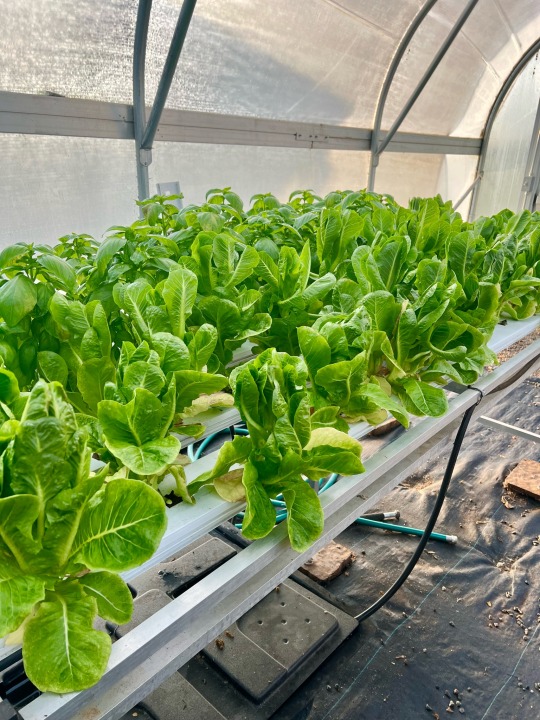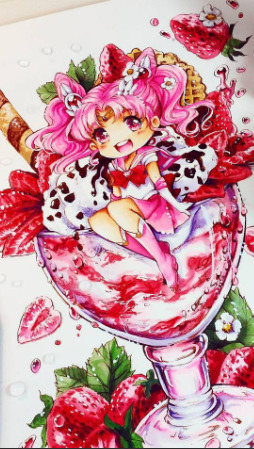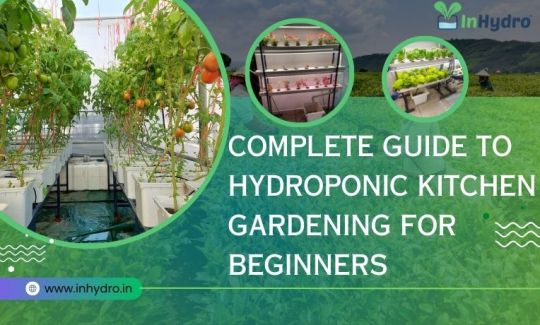#hydroponic seeds
Explore tagged Tumblr posts
Text
What plants can be grown hydroponically?

In the world of modern agriculture, hydroponic gardening has emerged as a revolutionary method of cultivating plants without soil, using nutrient-rich water solutions. This innovative approach offers numerous advantages, including efficient resource utilization, faster growth rates, and the ability to grow crops in environments where traditional farming may not be feasible. Among the myriad of plants that can thrive in hydroponic systems, some stand out for their adaptability and productivity.
Leafy Greens: Lettuce, spinach, kale, and other leafy greens are some of the most popular choices for hydroponic cultivation. They have shallow root systems and high water requirements, making them perfectly suited for nutrient-rich water environments. With the right hydroponic setup, these greens can be grown year-round, providing a consistent supply of fresh produce.
Herbs: Basil, cilantro, mint, and parsley are excellent candidates for hydroponic growth. These aromatic herbs flourish in controlled hydroponic environments, offering superior flavor and quality compared to their soil-grown counterparts. Hydroponic herb gardens are ideal for culinary enthusiasts seeking a convenient and sustainable source of fresh herbs.
Tomatoes: Tomatoes are another popular choice for hydroponic cultivation. They thrive in nutrient-rich solutions and benefit from the support of trellises or vertical systems. Hydroponically grown tomatoes often exhibit enhanced flavor and texture, making them a favorite among home gardeners and commercial growers alike.
Cucumbers: Cucumbers are well-suited for best hydroponic systems, particularly when grown vertically to maximize space efficiency. With proper support structures and nutrient delivery, hydroponic cucumbers can produce abundant yields of crisp, flavorful fruits throughout the growing season.
Peppers: Bell peppers, chili peppers, and other varieties can thrive in hydroponic environments. These plants require consistent moisture and nutrient levels, which can be easily maintained in hydroponic systems. With proper care, hydroponically grown peppers can yield bountiful harvests of vibrant, flavorful fruits.
Strawberries: Hydroponic strawberry production has gained popularity in recent years due to its ability to maximize space and optimize growing conditions. By utilizing vertical towers or hanging systems, growers can cultivate strawberries without soil, leading to cleaner, healthier fruits and increased yields.
Microgreens: Microgreens are young, tender greens harvested at an early stage of growth. They are packed with nutrients and flavor, making them a popular choice for salads, sandwiches, and garnishes. Hydroponic systems offer an efficient means of producing high-quality microgreens year-round, providing chefs and home cooks with a continuous supply of fresh, nutritious greens.
Potatoes: While traditionally grown in soil, potatoes can also be cultivated hydroponically, especially in potato vertical farming systems. With proper tuber support and nutrient delivery, hydroponic potatoes can yield impressive harvests in a fraction of the space required for conventional soil cultivation. Vertical farming techniques optimize space utilization, making them ideal for urban agriculture and limited land environments.
When it comes to choosing the best hydroponics system for growing these plants, several factors should be considered, including available space, budget, and desired crop varieties. Vertical farming systems, such as tower gardens or vertical hydroponic racks, offer an efficient solution for maximizing space and increasing yields. These systems allow growers to stack multiple layers of plants vertically, optimizing space utilization and productivity.
Hydroponic gardening offers a versatile and sustainable approach to cultivating a wide range of plants, from leafy greens and herbs to tomatoes, cucumbers, and even potatoes. By harnessing the power of nutrient-rich water solutions and innovative growing techniques like vertical farming, growers can achieve impressive yields of high-quality produce year-round. Whether for commercial farming operations or home gardening enthusiasts, hydroponics represents a promising frontier in modern agriculture, paving the way for increased food security and environmental sustainability.
#hydroponic gardening#hydroponic plant growth#hydroponic syteam#hydroponic plant#hydroponics store near me#vertical hydroponic garden#hydroponic garden tower#hydroponic tower garden#hydroponic lettuce#hydroponic tomatoes#hydroponic seeds#hydroponics tower#aquaponics vs hydroponics#general hydroponics#hydroponic planter#hydroponic nutrients#hydroponic weed#hydroponics for weed#hydroponic strawberries#hydroponic fertilizer
3 notes
·
View notes
Text
One of the Best Hydroponic Terrace Gardening | Inhydro

Are you interested in learning how to start a hydroponic terrace garden in India? If so, then you have come to the right place. In this comprehensive guide from Inhydro, you will learn everything you need to know about Hydroponic farming and setting up a successful terrace garden. We will explain all the basics of hydroponics and provide tips and tricks for successful hydroponic gardening in India. So, let's get started and learn all about Hydroponic terrace gardening in India.
#Hydroponic Kit for Home#hydroponic Kit for Home#hydroponic grow light indoor#Hydroponic light#grow light#Grow light for plants#Grow lights for indoor plants#Hydroponic Seeds#Hydroponic System#Terrace Garden kit#Rooftop Farming kit#Home Garden kit#Grow kit for gardening#Hydroponic grow lights#Hydroponic grow Bags#hydroponic grow System#Hydroponic setup#indoor grow kit#indoor plant accessories#Indoor gardening kit#Hydroponic tray
3 notes
·
View notes
Text


9/19/23 ~ Hydroponics at school. Those cucumbers grew super fast 😳 and some Romaine Lettuce!
#indoor garden#container gardening#sustainable gardening#vegetable gardening#starting seeds#grow organic#grow your own food#organic gardening#tomato garden#green witch#greenhouse#greenhouse nursery#plant nursery#hydroponics#growing cucumbers#romaine lettuce#sustainable agriculture
66 notes
·
View notes
Text
Growing & Cultivating Hydroponic Bonsai From Seed in the Southwestern US
Update 7
Previous update here
Disclaimer: Bonsai is an art form originating in China but largely introduced to the wider world by Japan. I haven't done scholarly reading about the history of the art form so I can't say with confidence that it's not supposed to be something sacred and precious and secret to any cultures within Japan or China. This world has a long history of violent colonialism and, in the context of Euro-American history, cultural appropriation and romanticization/mystification of Eastern Asian cultures. Asian people and cultures are treated as mysterious and strange and something to be ogled at. I am not trying to participate in Orientalism, I am not trying to take something that's not mine and act like it's magical because of where and who it came from. If I am failing in this regard, if the way I'm approaching this art form is appropriative and racist, I want to know so I can change and improve my behavior.
Meta Commentary (or, the state of this blog and series): I'm changing up the formatting of these posts, standardizing them. Every post will include, in order: 1) the cultural sensitivity disclaimer, 2) meta commentary about the blog itself if necessary, 3) a quick summary of where we left off, 4) things I've done and that have happened since then, 5) things I've learned and a general update on the state of things, and 6) my current agenda. I've also made a new blog so I can focus on the plants here rather than trying to dig through my main or personal blogs for forgotten plant posts. I'm also going to try to update weekly unless things are boring around here. Maybe monthly will be better but we'll try weekly first.
Where did we leave off? I last updated this series 16 October '24. I had a lot of C. linearis seedlings in peat pellets and seed starting soil, some in miniature greenhouses made from plastic waste and some in self-watering hydroponic planters made from glass jars. I didn't have any other plants. All of my plants were outdoors because freezing temperatures hadn't started yet.
What have I done and what's happened since? It's been 2 months. I've done a lot of things and a lot has happened.
I transferred a few plants from the greenhouses to planters. Some survived this process, some did not.
I got an LED grow lamp that can output monochromatic red light, monochromatic blue light, or both at the same time. I also got a timer switch.
I set up a shelf in my apartment that I can set the plants on during winter, and then I brought the plants in glass jars inside. I'm currently only using the blue light to try to get the plants to go into a partial dormant state.
I picked up 4 "Christmas trees:" one Norfolk Island Pine (Araucaria heterophylla) and three Ellwoodii (Chamaecyparis lawsoniana ellwoodii) (I have no idea why its common name is so weird and bland. It's a cultivar of Lawson's Cypress.)
I was given 3 Kalanchoe tomentosa succulents of the "Teddy bear" cultivar. Or, rather, a few leaves fell off my sister's and she gave them to me; apparently K. tomentosa just loves springing up from dropped leaves, so they should be easy to propagate. However, i definitely killed one by accidentally leaving it in my car overnight and then trying to grow it in a window rather than under the lamp.
I collected Arizona Cypress (Hesperocyparis arizonica) seeds from my neighbor's tree and started cold stratifying them, about half at above-freezing temperature and half at subfreezing temperature.
All of the outdoor plants died in subfreezing temps.
I'm still holding out a tiny bit of hope for those Japanese Maple seeds in the Spring but I won't be too sad if nothing happens with those.
I realized I should been changing the water in the planters weekly and that these plants need fertilizer; peat is a "soilless medium" that doesn't have any nutrients on its own. I also realized the peat pellets were restricting the roots, so I cut all of the peat pellets apart to give the roots more opportunity to grow.
The current state of affairs and things I've learned, species-by-species:
Japanese Maple (Acer palmatum): don't bother with seed starting kits, the instructions on the package are likely to be incorrect. Currently have 0 with a few seeds that might cold stratify properly outdoors over the winter.
Desert Willow: gather seeds and plant in the autumn, the seeds don't need to be cold-stratified and don't remain viable long. Planting them in high-humidity environments, y'know, the mini greenhouses, will help them germinate. They germinate well in peat pellets but quickly outgrow them. They also germinate fairly well in Kratky jars in the open air. They'll need fertilizer and regular water changes when planted in Kratky jars. Several are dead because I've been clumsy and because, despite the short shelf life of the seeds, the seedlings cannot stand winter temperatures. Currently have 4.
Norfolk Island Pine: they're tropical, they can't be outside year-round in my climate. They also don't develop and grow in a way that's conducive to typical bonsai techniques. This might never be a "true" bonsai. Currently have 1.
Ellwoodii: I don't particularly care for how they look as adults; I think I'll have to trim them quite a bit to get a look that I like. That's not going to be relevant until at least Spring but maybe not even until 2026. They should do fine in my climate so they'll be outdoors year-round after Winter. Currently have 3 but intend to give one as a gift soon.
Teddy Bear Succulent: allegedly easy to propagate from fallen leaves. Allegedly grow well in Kratky jars with leca. Tropical, ought to be indoors in winter and I think I'll keep them indoors year-round. My bathroom windowsill gets too cold for them in the winter; they have to be somewhere warmer in my apartment to survive. They also don't take well to being forgotten on a car dashboard (oops). Currently have two leaves sitting in soil in Kratky jars; I don't know whether they'll propagate.
Arizona Cypress: not much to say besides I've got a bunch of seeds chilling. Literally. You get a LOT of seeds from one single cone.
Overall: I have mold spores in my apartment. I need to do something to eliminate this so there's no mold growing on the soil of my plants. I think putting them outdoors in the Spring and giving them sunlight will kill the mold but I'm unsure and I'm worried. I'm trying to keep the humidity down in here in the meantime.
To-do: weekly water changes in the Kratky jars. Wait for Spring. Maybe try to do something about the mold? I'm worried I'll hurt the plants in the process, they're very young and small and delicate, I've killed a few by being clumsy. But I think it's just gonna be a lot of waiting, which is par for the course with bonsai and arboriculture in general.
#Bonsai#beginner bonsai grower#Growing & Cultivating Hydroponic Bonsai From Seed in the Southwestern US#Hydroponics#Plantblr
4 notes
·
View notes
Photo

#medical marijuana#seed oil#cannabis culturekw%#hydroponic weed#grow weed#dank#benefits of marijuana
28 notes
·
View notes
Photo

#medicalmarijuana#growops#joint#eatingmarijuana#marijuanamovment#Hydroponics#marijuana news#medical marijuana#sativa weed#Feminized Cannabis Seeds
11 notes
·
View notes
Text
a lot of plant posts make me angry because i was taught how to professionally grow plants as a very very young child like 3-4 and specifically to feel empathy towards them and it's usually very simple issues that cause the stuff that people are blaming the plant for causing. like if your plant is acting a certain weird way you are doing something wrong. but the soil isn't the issue with that situation lmfao. like trim it right back and put it in an actual light source and it'll be okay.
#i was taught how to do hydroponics and taught myself aquaponics like the seed being in water is not the issue here#seeds need more than just water with no nutrients added but it's fine to sprout it initially#reaching like that is a symptom of extreme fucking lack of light that the plant can eat#it is genuinely impressive it's upright still though i will say that#actually impressive as hell LOL
7 notes
·
View notes
Text


Grow your own deliciously sweet, intensely red strawberries get your seeds today!
#chibi art#sailor chibi moon#chibiusa#cute art#not my art#berry art#berry aesthetic#grow your own food#grow your food#gardening#fruits#urban gardening#container gardening#hydroponic garden#gardeners of tumblr#gardeners on tumblr#food security#vegetables#flowers#seeds#click the link#strawberry dream#strawberries#sailor moon
2 notes
·
View notes
Text
Catnip Herb Seeds - Heirloom, Non GMO

These seeds are heirloom and non-GMO, so you can rest easy knowing you're growing an organic herb. Stress Relief: Catnip Herb is known for its calming effects on cats and can also help humans relieve stress. Aromatic: This herb is also known for its minty aroma which can be used in teas, aromatherapy, and even for cooking. Pest Repellant: Catnip Herb is a natural pest repellent, so planting it in your garden can help keep unwanted pests away from your other plants. How do I germinate Catnip Herb Seeds? Catnip seeds can be sown directly in the soil or started indoors 6-8 weeks before the last expected frost. They will germinate in 5-21 days and should be planted in well-draining soil with a pH between 6.0-7.5. Can I plant Catnip Herb Seeds in pots? Yes, you can plant Catnip Herb Seeds in pots or containers. Just make sure the container has good drainage and the soil is well-draining. How often should I water my Catnip Herb plant? Catnip Herb likes well-draining soil and moderate watering. Water when the soil is dry to the touch, but do not overwater. "I don't have a cat, so why should I grow Catnip Herb?" Even if you don't have a cat, Catnip Herb has many uses including aromatherapy, teas, and as a natural pest repellent. "I don't have a green thumb and I'm not good at growing plants." Catnip Herb is an easy-to-grow herb that can be grown indoors or outdoors, making it a great option for beginners. "I'm not sure if I'll like the taste or smell of Catnip Herb." Even if you're not a fan of the aroma or taste of Catnip Herb, it's still a great option as a natural pest repellent. Don't miss out on the chance to grow your own organic Catnip Herb. Buy your heirloom and non-GMO Catnip Herb Seeds today and enjoy all the benefits this herb has to offer. Read the full article
#Aquaponics#cat#Catnip#Cats#garden#Heirloom#herb#Hydroponics#NonGMO#OpenPollinated#Organic#seeds#Vegan
4 notes
·
View notes
Text
Jolly Green Hydroponics, LLC
"It's Where ALL the Growers Get Their Jollies!"
We’re excited to introduce our new family of websites!
Jolly Green Hydroponics is expanding to better serve the cannabis cultivation community with specialized services and premium products. Whether you're looking for expert consulting, commercial greenhouse equipment, or top-tier cannabis genetics, we've got you covered.
Our Offerings:
✔ Commercial Cannabis Cultivation Consulting – Book online for expert guidance on licensed facility operations.
✔ Online Store – Equipment & Garden Supplies – Get commercial greenhouse equipment & specialty gardening supplies, shipped factory direct.
✔ Online Store – Premium Cannabis Genetics – Featuring top-tier genetics from multiple U.S. breeders.
✔ Hydroponic & Organic Living Soil Consultation and Supplies
Explore Our New Websites:
🌱 Jolly Green Hydroponics – Greenhouse Equipment & Gardening Supplies
🔗 jollygreenhydroponics.com
💡 Jolly Green Consulting – Expert Licensed Cannabis Cultivation Consulting
🔗 jollygreencannabisconsulting.com
🌿 Jolly Green Genetics – Premium Cannabis Seeds & Genetics
🔗 jollygreencannabisseeds.com
Follow us for updates and insights into commercial cannabis cultivation! #JollyGreenHydroponics #CannabisConsulting #Hydroponics #OrganicSoil #Growers #CannabisGenetics


0 notes
Text
Jolly Green Hydroponics, LLC
"It's Where ALL the Growers Get Their Jollies!"
We’re excited to introduce our new family of websites!
Jolly Green Hydroponics is expanding to better serve the cannabis cultivation community with specialized services and premium products. Whether you're looking for expert consulting, commercial greenhouse equipment, or top-tier cannabis genetics, we've got you covered.
Our Offerings:
✔ Commercial Cannabis Cultivation Consulting – Book online for expert guidance on licensed facility operations.
✔ Online Store – Equipment & Garden Supplies – Get commercial greenhouse equipment & specialty gardening supplies, shipped factory direct.
✔ Online Store – Premium Cannabis Genetics – Featuring top-tier genetics from multiple U.S. breeders.
✔ Hydroponic & Organic Living Soil Consultation and Supplies
Explore Our New Websites:
🌱 Jolly Green Hydroponics – Greenhouse Equipment & Gardening Supplies
🔗 jollygreenhydroponics.com
💡 Jolly Green Consulting – Expert Licensed Cannabis Cultivation Consulting
🔗 jollygreencannabisconsulting.com
🌿 Jolly Green Genetics – Premium Cannabis Seeds & Genetics
🔗 jollygreencannabisseeds.com
Follow us for updates and insights into commercial cannabis cultivation! #JollyGreenHydroponics #CannabisConsulting #Hydroponics #OrganicSoil #Growers #CannabisGenetics


1 note
·
View note
Text
#hydroponics store near me#vertical hydroponic garden#hydroponic garden tower#hydroponic tower garden#hydroponic lettuce#hydroponic tomatoes#hydroponic seeds#hydroponics tower#aquaponics vs hydroponics#general hydroponics#hydroponic planter#hydroponic nutrients#hydroponic weed#hydroponics for weed#hydroponic strawberries#hydroponic fertilizer
1 note
·
View note
Text
Complete Guide to Hydroponic Kitchen Gardening in India for Beginners | Inhydro

Welcome to Inhydro complete guide to Hydroponic kitchen gardening in India for beginners. With the help of this guide, you'll learn all about the basics of hydroponic kitchen gardening and how to get started on your own hydroponic kitchen garden in India. We'll explore the various hydroponic systems, tools, and supplies that you'll need, as well as provide tips and tricks for maintaining and caring for your hydroponic garden.
#Hydroponic Kit for Home#hydroponic grow light indoor#Hydroponic light#grow light#Grow light for plants#Grow lights for indoor plants#Hydroponic Seeds#Hydroponic System#Terrace Garden kit#Rooftop Farming kit#Home Garden kit#Grow kit for gardening#Hydroponic grow lights#Hydroponic grow Bags#hydroponic grow System#Hydroponic setup#indoor grow kit#indoor plant accessories#Indoor gardening kit#Hydroponic tray#Hydroponic nutrients#Hydroponic kit outdoor#hydroponic kit for balcony#Hydroponic kit for home garden
1 note
·
View note
Text


9/7/23 ~ Started school, been learning greenhouse hydroponic stuff & harvesting some veggies & flowers! I’m loving it so far.
I really need to start some of my seeds at home. I started pumpkin in august - I need to transplant it. And I have some Chinese broccoli growing as well. I don’t have a lot of experience with fall/winter gardening. So I’ll share as I go 😅 Trials and errors 😆
#indoor garden#container gardening#sustainable gardening#vegetable gardening#starting seeds#grow organic#grow your own food#tomato garden#sustainable agriculture#sustainable#horticulture#hydroponics#greenhouse
10 notes
·
View notes
Text
Growing & Cultivating Hydroponic Bonsai From Seed in the Southwestern US
Update 10
Previous update here
Disclaimer: Bonsai is an art form originating in China but largely introduced to the wider world by Japan. I haven't done scholarly reading about the history of the art form so I don't know if it's sacred to any cultures within Japan or China. This world has a long history of violent colonialism and, in the context of Euro-American history, cultural appropriation and romanticization/mystification of Eastern Asian cultures. Asian people and cultures are treated as mysterious and strange and something to be ogled at. I am not trying to participate in Orientalism, I am not trying to take something that's not mine and act like it's magical because of where and who it came from. If I am failing in this regard, if the way I'm approaching this art form is appropriative and racist, I want to know so I can change and improve my behavior.
Meta Commentary: I'm sticking with the weekly update schedule, I just wasn't having a great time last weekend. Sorry.
Where did we leave off? Last update was 12 Jan '25
DW: One had died but the other 3 seemed ok. I also gathered some more seeds. 3 live plants and a lot of seeds.
NIP: doing good, nothing to say about it. 1 live plant.
OE: In the open air with the roots insulated. Seemed to be recovering? Wasn't sure the best way to water them given the lack of drainage. 2 live plants.
IE: doing good despite common wisdom saying it should be outdoors. 1 live plant.
TBS: just sitting there. No idea if they're alive. Maybe they're growing roots, maybe they're dead.
Overall: I started using fungicide in the PKPs.
What have I done and what's happened since? / The current state of affairs and things I've learned:
DW: I planted one of the seeds; I'm gonna try to keep 4 alive at a time. Still hasn't sprouted. I also realized it's been a while since I saw signs of growth from the living plants, but they're still green and soft, not crunchy or otherwise dead-looking. I think they're in a sort of stasis? Not sure. 3 live plants, 1 seed that might sprout, a lot of unplanted seeds.
NIP: this thing is almost boring in its refusal to do anything but thrive. But. It's alive so I'm doing something right; I'm not complaining. It's not a pet, it's not gonna do anything crazy, it's a tropical conifer tree in a pot, it's just gonna sit there. 1 live plant.
OE: they got crunchy again, so I put pickle jars over them. I was worried about the lack of air flow so I replaced the pickle jars with semi-transparent ice cream tubs instead. I'm just dripping a little bit of water into the styrofoam cooler; hopefully I'm not overdoing it (or underdoing it). They're turning brown but they're no longer crunchy; Idk what to think. 2 live plants maybe?
IE: still inexplicably doing good despite not being in the cold the way it'll have to be next year. I'm keeping it inside; if it's stupid but it works, it's not stupid.
TBS: Are they propagating? No idea. Actually hang on a sec I'm gonna look something up. Hell, I still don't know for sure. Maybe they needed red light in addition to the blue light I've been using? Soil might be too moist? If they're gonna grow roots, they've done it by now but I still won't know for sure until it's been like 6 weeks; they should have new leaves by then.
Arizona Cypress: the seeds have been cold stratifying for almost 90 days; it's almost time to plant them. I'm not sure where to plant them, though, because there's no room on the plant shelf but planting them outdoors right now will just kill them because it's too cold. Eugh. Might need to make another shelf, might need to buy another light.
Piñon (Pinus edulis): I got some seeds and they're cold stratifying now. I'm going to plant them in three batches, the first at 30 days of cold stratifying, the 2nd at 60, the last at 90.
Overall: if this mold is poisonous to indoor plants, I'm not gonna be able to grow indoor plants and that's all there is to it. I'm stopping fungicide use when I run out of the current batch of diluted fungicide.
To-do:
Maintain current routine
Figure out what I'm doing with these AZC seeds, then do it.
#beginner bonsai grower#bonsai#hydroponics#plantblr#kratky method#Growing & Cultivating Hydroponic Bonsai From Seed in the Southwestern US#succulents#kalanchoe tomentosa
6 notes
·
View notes
